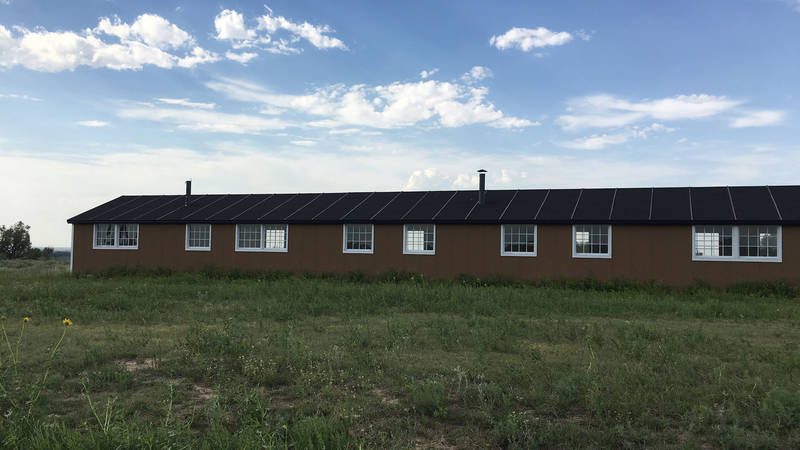- State: CO
- NPCA Region: Southwest
- Est. Date: 2022
This national park site preserves the story of Amache, where thousands of people of Japanese descent were unconstitutionally incarcerated.
During World War II, President Franklin D. Roosevelt issued an executive order forcing more than 120,000 people, primarily of Japanese descent, to relocate to 10 remote, military-style prisons. Amache, also known as the Granada Relocation Center, was one of these 10 incarceration centers.

Victory: President Biden, Parks Leaders Welcome Amache National Historic Site
“By preserving Amache, we can ensure that as a country we confront our mistakes, honor the stories of those who were unjustly imprisoned, and protect the site for future generations"…
See more ›Two-thirds of the people at Amache were American citizens. Many others were first-generation Japanese elders who had immigrated from Japan and were denied U.S. citizenship for decades. Most were given a week or less to dispose of everything they owned, with no idea where they were going or what would happen. One thing was clear: They were not welcome in California, Oregon or Washington because they had Japanese faces and names.
Amid this tragedy, the people imprisoned at Amache created an entire town and established a form of democratic self-governance. Many even volunteered to serve in the military during the war — nearly 10% of people at the site, the highest percentage of all the incarceration camps.
Yet Amache was unmistakably a prison. People lived with a constant presence of armed guards, behind barbed wire, in shoddily built barracks. For many, a sense of family unity was destroyed.
Survivors, descendants and advocates, including NPCA, worked for years to preserve the history at Amache and include the site as part of the National Park System.
More about Amache
-
Read more about Amache Preserved as Part of the National Park System
Victory Amache Preserved as Part of the National Park System NPCA helped advocate for a national park site preserving the story of Amache, where thousands of people of Japanese descent were unconstitutionally incarcerated.
-
Read more about Confronting America's Dark Past
Blog Post Confronting America's Dark Past 80 years ago, the federal government imprisoned innocent civilians for their Japanese ancestry. Today, survivors and their descendants fight to preserve the sites where these injustices took place — and to not let history repeat itself.
-
Read more about Amache Japanese American incarceration site on verge of becoming national park site
Press Release Amache Japanese American incarceration site on verge of becoming national park site Unanimous Senate and House passage puts preservation campaign waged by survivors, descendants and advocates near completion
-
Read more about The Day of Remembrance Marks Need for Continued Japanese American Incarceration Site Protections
Press Release The Day of Remembrance Marks Need for Continued Japanese American Incarceration Site Protections Conservation group advocates for further protections to honor survivors and descendants’ experiences.
-
Read more about Amache National Historic Site Act Passes Senate Committee, Heads To Full Senate Consideration
Press Release Amache National Historic Site Act Passes Senate Committee, Heads To Full Senate Consideration Japanese American survivors and descendants of the Amache Incarceration site are one step closer today to preserving the area into a national park site.
-
Read more about Bill to make Japanese American incarceration camp a National Historic Site passes U.S. House
Press Release Bill to make Japanese American incarceration camp a National Historic Site passes U.S. House The Amache National Historic Site Act permanently protects the Colorado landmark and will ensure the survivors’ stories are remembered
-
Read more about Parks group welcomes bipartisan bill to make Amache a National Historic Site
Press Release Parks group welcomes bipartisan bill to make Amache a National Historic Site The Amache National Historic Site Act will permanently protect the former incarceration camp and ensure the survivors’ stories are told and remembered
-
Read more about Ask Congress to Support the Amache National Historic Site Act (H.R. 2497/S.1284)
Fact Sheet Ask Congress to Support the Amache National Historic Site Act (H.R. 2497/S.1284) Introduced by Congressman Joe Neguse (D-CO) and Ken Buck (R-CO) and Senators Michael Bennet and John Hickenlooper, the bipartisan Amache National Historic Site Act (H.R. 2497/S.1284) would make the Granada Relocation Center, a World War II Japanese incarceration site in Colorado known as “Amache”, a National Park. The legislation has passed in the House and will be up for a vote in the Senate.
-
Read more about Amache: An American Story That Must be Told
Blog Post Amache: An American Story That Must be Told An interview with Mitch Homma, whose family members were incarcerated at Amache during World War II simply because of their Japanese ancestry.
Preserve Our Parks
Make a tax-deductible gift today to provide a brighter future for our national parks and the millions of Americans who enjoy them.
Donate Now